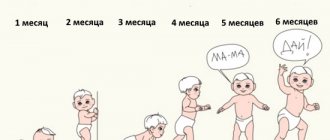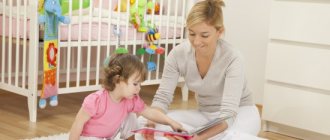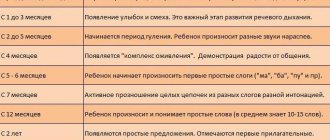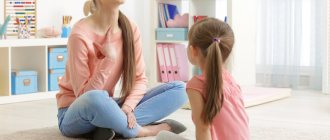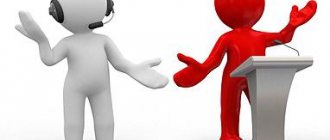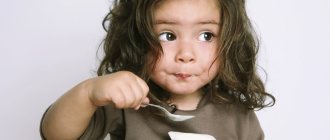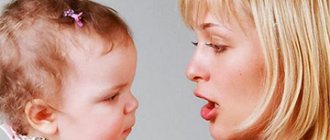A new stage is coming in his, and in your life. The literature on psychology and pedagogy usually talks in detail about the first year of life, since it is then that the most significant changes in a child’s development occur, and then about three-year-olds, because it is at three years that the famous psychological crisis occurs. But the period from one to two years is no less important in personality development.
The baby can already understand a lot, but it is still very difficult for him to express his thoughts and desires in words. And how much I want to say! Help him. To do this, you need to purposefully develop the speech of your little one. The better you understand each other, the less reason the baby will have for whims and hysterics.
Let's figure out how speech develops at this age.
Stage one: first words
From a year to a year and a half, the baby begins to move very actively in space and accumulate new experiences. This experience is necessarily reflected in speech development.
Usually the first words appear at the age of 9.5 months - 1 year 6 months. Most often they designate the closest people: mother, father, woman, uncle, aunt. The baby can easily reproduce onomatopoeic words: aw-aw (dog), tick-tock (clock), mu-mu (cow), etc. Often, instead of a whole word, a child pronounces an initial or stressed syllable (ko instead of cat or bura instead of Cheburashka). But since these “words” mean specific things and are pronounced in a certain situation (at the sight of a cat or Cheburashka), we can call them words, and not random syllables.
It has been noticed that some children “love” nouns denoting objects and people more, while others prefer verbs associated with social interaction – “go away”, “want”, “give”, etc.
The first words have a broad generalized meaning. However, this is not at all the generalization that we are used to when calling a doll, a bear and a ball as toys. For now, the child singles out one feature and combines a variety of things based on it. So, the word “yum-yum” is used by a one-year-old child to describe all kinds of food, as well as the dishes from which he is fed. When he gets hungry, he also shouts “Yum-yum!” (=I’m hungry!), and when he sees a teenager chewing gum on the street, he comments: “yum-yum” (=eating).
Little Lisa used the word “una” (moon) to call all round-shaped objects - pancakes, round spots on window glass, circles in books, postmarks on envelopes, round embossed frames on book bindings, the letter “O”. And Fedya decided to generalize the sounding objects. The word “ko-ko”, which at first in his dictionary meant a crowing rooster, Fedya began to call the sounds of a violin, piano, accordion, any music and musical toys. Texture can also become a general principle: the word “woof-woof” was used by Katyusha not only for a dog, but also for all furry animals, soft slippers, and even a photograph of an old man in a fur coat.
Child care per year
It is believed that 12 months is the optimal time to teach children hygiene procedures, as they begin to develop independent behavior skills and habits. Daily hygiene activities should become part of children's routine.
- In the morning, after the final awakening, wipe the child’s face with a damp cotton pad (for rashes, boiled water, as well as an infusion of chamomile or string herbs, are suitable).
- Brush your children's teeth with a simple gauze cloth or a special silicone brush that fits on your finger.
- Check the nose, eyes and ears, carefully removing mucus, crusts and wax.
- Wash your baby after sleep and give him an air bath for 10-15 minutes to give the skin a rest from the diaper.
It is advisable to take such breaks from wearing a diaper several times a day, allowing the skin to breathe - this is an excellent prevention of diaper dermatitis. If it is present, and also if there are sweaty folds or rashes on the child's skin, you can treat it with a cotton pad with baby lotion, or use baby cream.
Diapers for children older than six months must be changed when they are full. After each bowel movement, the child should be washed with movements from front to back, from the perineum to the buttocks. If you notice that your child is trying to take off his diaper during the day, you can try introducing him to the potty. Some one-year-old children are already able to master it.
In the evening, the entire algorithm is repeated, with the difference that immediately before bed the child needs to brush his teeth or at least drink boiled water. During the day, after each meal, the child is also recommended to drink a little water to clean the mouth of food debris.
You can bathe a one-year-old child every other day, the duration of the bath is 10-20 minutes, followed by an air bath.
All personal hygiene products for the child - towel, soap, washcloth, etc. - must be individual and suitable for his age.
It is enough to cut your nails once a week.
"Y?"
During this same period, children are very fond of pointing with their finger at an object that interests them with the question word “Y?”. Parents are often annoyed by this; they believe that it is indecent to behave this way. But such a gesture is very important for speech development! Do not forbid doing this under any circumstances, and, moreover, help the baby master such a gesture if necessary.
The famous Russian psychologist L. S. Vygotsky believed that the pointing gesture was originally simply a failed or unfinished grasping movement. “The child is trying to grab an object that is too far away; his hands, extended to the object, remain hanging in the air... There is a movement here that objectively points to the object, and nothing more. But when the mother comes to the child’s aid and interprets his movement as an instruction, the situation changes significantly. The pointing gesture becomes a gesture for others.”
Thus, the baby makes an amazing discovery: everything around has its own name - everyone, every object! "Y?" with a pointing gesture is a greedy question: “What is this?” This is a cat, and this is a house, and this is a big dump truck... Passive vocabulary (i.e. words that a child understands, but cannot reproduce himself) is becoming richer each time, and someday it will certainly turn from passive into active (active vocabulary is the words that the child pronounces).
First words
The baby understands the meaning of simple speech and address. But for now he focuses more on intonation than on words, although he knows the meaning of certain phrases. Talk to your child more often - and his vocabulary will grow day by day, even if this vocabulary is still passive (understandable, but not used in speech). In a year, the baby already understands about 10 words and expressions, including onomatopoeia (for example, if “meow” is “kitty”).
If your child doesn't say anything at all, don't panic. The main thing is that he understands your phrases and addresses. If there is no understanding, be sure to consult a pediatrician, because the baby may have auditory, psychological or neurological disorders that need to be compensated in a timely manner.
Tactics of your actions
As before, the main thing is to communicate with your baby! Having caught his interested glance or pointing gesture, name the objects that surround you and comment on your actions. Don’t be shy about talking out loud and on the street - it’s very important for your baby to hear from you what’s happening in the sandbox, where passers-by are rushing, and what color that beautiful aunt’s dress is.
Try to ensure that your comments do not remain only sound, but have some kind of reinforcement in bodily sensations and movement. The baby will remember the word “tree” much better if he touches the rough bark with his palm, the word “handkerchief” - when he tries to tie a scarf on a doll, the word “bell” - if he rings a real bell.
Try to “introduce” a new word to your child in various combinations with other words and objects. For example, when showing milk, show what it looks like in a glass or in a pan in which you are going to cook porridge. Comment on your actions: “Mom pours milk into a glass”, “white milk, delicious”, “drink milk”, etc.
It is useful to consider and discuss not only various objects, but also pictures with their images. After all, by this age, children are already quite good at identifying an object and its image. Compare real things with pictures. What do they have in common and how do they differ? For example, if you see a photograph of a girl in a red hat in a magazine, find your baby’s hat and compare: “The girl has a hat, and Alyosha has a hat. The girl’s hat is red, and Alyosha’s is yellow,” etc.
How can yearlings take care of themselves and what can a child learn at 1 year old?
If you give your baby the opportunity to be independent, then by 12 months he will learn:
- wash and dry your hands;
- hold a spoon (and possibly a fork) in your hands and use them;
- chew well, bite off solid food, and after chewing, swallow it;
- drink from a small cup or sippy cup;
- take an interest in the potty and start using it (the baby understands the logical chain between natural needs and the potty, especially if you taught him to use it with some kind of conventional sign or sound);
- make attempts to dress and put on your shoes on your own (especially if in your free time you give your child his clothes so that he has the opportunity to practice).
Of course, the child masters all of the above skills not only on his own, but largely thanks to adults. If you give him the opportunity to develop independently, but at the same time you pay a lot of attention to communication and comments from the world around him, you will be surprised at the abilities of your one-year-old. And a couple of years later, you will remember with a smile what exactly your child was able to do in a year.
First generalizations
Gradually, the baby establishes a connection not only between a specific object and a word, but also between other similar objects and this word. How does this happen?
Here, for example, is an experiment that was conducted by psychologists with young children.
The experiment involved two groups of children aged from 1 year to one year and 3 months. In the first group, each child for two months, almost every day, was shown an unfamiliar object - a book - 10 times for five seconds and said: “Book! Book!" Each time the children turned their gaze and turned their heads towards the object. During the observation period, this reaction was repeated 500 times.
With the children of the second group, one book was also used, but the child, under the guidance of an adult, performed various actions with it. “Here is a book!”, “Open the book!”, “Close the book!” etc. The kids were given only 20 different commands; each of them included the word “book”, and each required a specific motor response. These motor reactions were repeated only 50 times during the entire observation period.
Control tests were then carried out in both groups. During these tests, many different objects were laid out in front of the child: cubes, dolls, toy animals, several books that differed in size, thickness, cover color, etc. The adult addressed the child with the words: “Give me the book!” It was important to find out which book the child would choose. Only the one he saw before, or any other, uniting the objects with the concept of “book”? Children from the first group took only one book - the one they had seen during the previous two months - and gave it to the experimenter. When they were asked to take another book, they either took the first object they came across (it could be a doll, a hare, etc.) or did nothing. This means that for the children of this group the word “book” remained the name of one specific object and did not acquire a general meaning. So a large number of repetitions, even with the simultaneous presentation of the corresponding object, does not yet contribute to the development of generalization.
And therefore, teach your baby to act with various objects, be sure to name these actions out loud.
You can bring the same book, show it to the doll, open it, close it, leaf through it, put it on a chair, find an interesting picture in it, etc. Contact your baby more often with various simple requests. He will be very happy to help you, and at the same time he will enrich his vocabulary and gain the first experience of generalization.
Achievements of the first 12 months
By the time of 12 months, the baby arrives with certain achievements.
Here's what a year-old child can most often do:
- observes with the eyes a moving object or light;
- follows the sound and object of the toy with his eyes, pulls his hands towards it;
- smiles;
- holds his head upright;
- quickly and deftly rolls over from one side to the other, onto the stomach and back onto the back;
- sits and stands confidently with support, takes the first steps;
- hums, pronounces the first syllables and words.
Nursery rhymes and jokes
In a sense, various nursery rhymes and jokes are ideal first literary texts that a child perceives literally with mother’s milk. After all, they describe real life experiences, the world around them, comment on various natural phenomena, etc. At the same time, the clear rhythm and melodiousness of nursery rhymes help the child easily learn new concepts and sometimes do what he doesn’t really want, but is necessary. For example, you can wash your face with this nursery rhyme:
- Some water, some water, wash Vanya’s (Masha’s) face,
- To make your cheeks blush, your eyes to shine,
- So that the mouth laughs, so that the tooth bites.
At the same time, we will teach the first lesson on the structure of the body and show where our face, cheeks, eyes, mouth and teeth are. Then, after washing your face, you can repeat the nursery rhyme again, this time depicting how to wash your face, not forgetting about your eyes or cheeks.
Your baby is a little one, and feeding him is a big problem? Perhaps another nursery rhyme will come to the rescue:
- The donut, the flatbread, was sitting in the oven, looking at us, and wanted to put it in her mouth.
Or this:
- I’ll bake Tanya a pie,
- I’m already blushing for my granddaughter.
- It has a wheat crust,
- And the filling is egg,
- And the honey shaving brush,
- My granddaughter is in trouble.
- These nursery rhymes can be read while eating.
- When putting a shirt on your baby, say:
- Aunt Agashka, sew me a shirt:
- I need to dress up and go for a ride!
They also tell nursery rhymes about natural phenomena. For example, about rain:
- Rain, rain, more!
- We'll give you the grounds
- We'll give you a spoon:
- Sip a little!
And try to “drive away” the lingering rain with this nursery rhyme:
- Rain, rain,
- Pour it full,
- Get the little kids wet!
Nursery rhymes also emphasize the baby’s new skills: for example, learning to walk:
- Katya, Katya, little,
- Katya is remote,
- Walk along the path
- Stomp, Katya, with your little foot.
Or:
- Bunny, walk around,
- Gray, walk around,
- Like this, like this
- Like this, like this!
The first steps, of course, cannot be imagined without numerous falls and bruises. Stroke the bruised area, saying:
- The cat is in pain
- The dog is in pain
- And Andryusha is not in pain,
- Andryusha's pain will fly away to the birch tree.
In this kind of nursery rhymes there is, among other things, a deep psychotherapeutic meaning. They allow you to take your mind off the pain, and therefore relieve the tension associated with pain. Such psychological treatment is quite effective for the baby.
By the way, did you know that perhaps the most famous finger game, “Magpie-Magpie,” did not end with the wiggling of the idle little finger:
- You didn't chop wood
- Didn't carry water
- There will be no porridge for you.
The game has a sequel. Adult says:
- I went looking for it myself:
- The water here is cold (stroking the baby’s wrist),
- It’s warm here (stroking her elbow),
- It's hot here (stroking her shoulder),
- And here - boiling water, boiling water, tickling! (adult tickles child under arm)
After all, the point of this nursery rhyme is not only the development of fine motor skills. It gives the child the joy of physical contact, the opportunity to feel his fingers, elbow, shoulder, and ultimately, to form an idea of his body.
There are special nursery rhymes for putting a child to sleep. They can become part of your ritual that gets your baby ready for bed. For example, you can put a fluffy toy kitten in the crib, which will “cradle” its little owner:
- Come, little kitten,
- Come, little gray tail,
- Come, cat, spend the night,
- Come and play with Dashenka.
- How am I for you, cat?
- I will pay for the work:
- I'll sew a new fur coat
- And I'll order boots.
Stage two: first phrases
In fact, the first phrases, strange as it may sound, were already contained in single words. After all, single words for a baby are a whole complex of different ideas. Thus, the word “mama,” pronounced in different situations, with changing intonation and accompanied by different gestures, can mean: “I want to go to my mother,” “Mom, tie my lace,” or “Here is my mother.” The child found a beautiful button on the floor, picked it up and invited his mother to admire it: “Mom! Mother!" And when he fell, his plaintive whimper also sounds: “Ma-ma-a-a!”
However, after your baby turns one and a half years old, you will most likely hear his first “real” phrase: “Mom, give me!” or “Dad, go!” etc. At approximately 1 year 8 months - 1 year 10 months, the baby well masters the imperative mood of the verb and plural forms, and by two years - the case forms of nouns (although this process will finally end by 3-4 years).
In girls, the combination of words into phrases occurs a little earlier, in boys - two to three months later. After the first phrase is uttered, speech development usually proceeds very rapidly. Almost every day you can hear more and more new phrases from your baby. However, keep in mind that the baby, as before, needs your attention and response. If there is no answer or it is monosyllabic and not emotional, then interest in speech activity is lost and development is inhibited.
It is very important to show your child that you understand him and to “translate” his first awkward words into ordinary, correct adult language.
Here's an example. Mom is preparing dinner in the kitchen. The baby watches her, sitting on a high chair.
"But!" - says the baby, seeing the knife with which his mother is going to cut vegetables. “Yes, it’s a knife,” my mother agrees.
"Get sick!" – adds the child.
“Big knife,” mom “translates,” imperceptibly combining both words into a phrase, and adds: “We’ll cut the cabbage with a big knife.” Such a “translation” will contribute to a faster and more successful combination of words into a sentence.
Don’t be afraid of “wrong” baby words, they will definitely turn into “real” ones someday. Appreciate the child’s attempt, even if not yet very successful, to share his life experience with you. This will give him confidence in his abilities and a feeling of being understood.
Nutrition for a one-year-old child
At one year of age, children enter a transitional stage in nutrition, because they develop teeth and chewing skills, and the gastrointestinal tract already allows them to digest and assimilate more complex foods. In addition, taste preferences are gradually expanding.
Up to one and a half years, you can leave five meals a day, but if you notice that the child refuses the last meal, then you should try to remove it, leaving only breakfast, lunch, afternoon snack and dinner. This is the required minimum. You need to feed your child by the hour (remember the routine?), and if your plans include attending kindergarten, it is better to “adjust” the schedule to it.
The daily diet should be 1100-1200 ml of food with a puree consistency.
Breakfast and dinner should account for approximately 1/4 of the total daily requirement, lunch - 1/3, the rest - for afternoon snacks.
Approximate amount of food that a child can consume per day:
- breast milk/formula and kefir – 500-600 g;
- vegetables – 200-350 g;
- fruits – 200 g;
- porridge – 200 g;
- meat – 75 g;
- cottage cheese – 50 g;
- eggs – 40-50 g;
- bread – 40 g;
- fish – 30 g;
- sugar/fructose – no more than 40 g.
These are the main products for feeding a one-year-old child; the entire children's diet consists of their combinations. It should be taken into account that children are often allergic to eggs and fish, and legumes cause bloating and diarrhea.
For porridges, it is better to choose buckwheat and oatmeal; these cereals are rich in carbohydrates, vitamins and minerals. Once every few days you can cook rice porridge - it helps improve digestion, but is not rich in vitamins.
Industrial sweets - cakes, pastries, sweets, caramel, chocolate - should not be given to children. Give preference to natural treats - marshmallows, marmalade.
Since the child is also a person, and sooner or later he will get tired of eating the same thing, you can add 5-10 g of cheese, sour cream, sunflower or other vegetable oil to the menu. Salt – no more than 3 g per day.
Healthy one-year-old children no longer need night feedings, so sleep and food should be separated. Any food and drink, except water and breast milk, consumed at night is harmful to teeth, overloads digestion and worsens appetite during the day.
You can give relief and return night feeding when the child feels unwell or is actively learning a new skill, but when the acute period is over, night meals should be eliminated again.
It is also advisable to leave breastfeeding only in the morning and before bedtime.
It is necessary to offer the child something to drink between feedings - use boiled water or weak tea for this. Let your child have access to his bottle or sippy cup. To quench your thirst, you should not use juices and compotes; they are sweet and will not cope with the task. Save them for meals.
Story play and speech
It happens that a child between the ages of one and two does not speak and does not play at all. In this case, first of all, try to teach him to play.
At first glance, it seems that the story game has nothing to do with the development of speech. However, in reality this is not entirely true. A one-year-old child not only communicates his desires and problems through speech, he also tries to share his impressions with an adult. So, when a baby points his finger at a car, he wants to say: “I saw a car, look at it too!” But in order to name any objects, the child needs to remember them. Moreover, remember not as abstract concepts, but as experienced through your own experience. And the simplest plot game will help him with this - feed the doll, put it to bed, sing it a lullaby, walk with it along the path. With the help of real, simple actions, the child works through his experience in play, and this experience is consolidated in speech. If before the child did not seem to notice what he was doing, now he pays special attention to the actions. And therefore, story games that repeat the actions of the baby himself must be commented on: “The bunny walks, jumps, digs with a shovel.” Show your child how to play with this or that toy, and soon he will begin to repeat your play stories.
You can compose and show your child simple and short scenes with toys. For example, a bear fell and cried, or a doll lost a ball and is looking for it. Ask your child to help his little friends.
The same nursery rhymes and jokes that we talked about above can be played with toys. For example, like this:
- Big feet walked along the road:
- To-o-op, to-o-op, to-o-op, to-o-op (pronounced slowly, in a low voice).
- Little feet ran along the path:
- Top-top-top, to-o-op (pronounced in a high voice and quickly).
Compare the baby’s leg and the adult’s leg, show how one walks. Now find two similar toys of different sizes (two bears, bunnies or dolls), build different paths for them from cubes (wide and narrow) and let your toy characters walk either slowly or quickly. See how many concepts a child will learn from such simple fun: big, small, slow, fast, wide, narrow!
Behavioral problems of one-year-old children and ways to solve them
Children's tantrums are a topic to which serious scientists devote scientific articles. Their real reasons most often lie in a combination of the child’s personal qualities, immediate circumstances and behavioral development processes.
It is tantrums that occur more often in children from 2 years of age, but 12 months is the boundary between the period of infancy and early childhood, when the worldview changes. The child begins to realize himself as an individual, his own will is formed. For the child’s psyche, this is a difficult test, because, although aware of his “wants”, as well as the difference between “possible” and “impossible”, the child does not yet understand the reasons for the prohibitions.
In a year, the first age crisis occurs, and childish stubbornness also makes itself felt.
Crisis of 1 year of life
If your usually accommodating child began to express his desires in the form of whims and hysterics, there was a clear tendency towards touchiness, tearfulness, and stubbornness - these are signs of a psychological crisis in the first year of life. Additionally, the child is upset that attempts to do something on his own lead to failures, because he is not yet physically developed enough.
At this stage you need to be patient. The main task is not to react aggressively to the child’s behavior and learn to set boundaries for what is permitted.
What should parents do when their child has a crisis in the first year of life?
- Set boundaries. There should not be too many prohibitions, but they must be constant - what is not allowed is always not allowed, unless the parents allow it - none of the relatives/teachers allows it.
- Allow your child to take the initiative and do accessible things on their own, helping if necessary. This will strengthen his self-confidence.
- Don't force feed. Many people refuse to eat during their first age crisis. Even if you have a meal schedule, do not force your child to eat through hysterics. Offer him food when he asks.
- Whenever possible, comply with your child's requests. Attention and confidence in the help of parents increases the child’s trust in the world.
- Ask for help. The opportunity to help parents pleases the child and brings him pleasure. Praise from loved ones is an important emotional factor in development.
- Don't feed the hysteria. Do not shout or try to forcefully stop this behavior. Realizing that the manipulation does not work, the child will calm down.
- Distract your child from negative emotions, but do not indulge his weaknesses by giving him sweets at the slightest sign of an emotional outburst, do not pick him up on demand and do not use gadgets for this.
Nimble fingers
Training fine finger movements has a great influence on the development of a child’s active speech. This phenomenon has long been known to psychologists and speech therapists. And they never tire of repeating how important it is to develop fine motor skills. A variety of finger games, manipulations with paper (it can be torn into small pieces, crumpled, crumpled), and unscrewing and tightening the lids on cans and bottles will help with this.
As always, an inexhaustible resource in this regard is an ordinary kitchen. My child, for example, really liked hiding small toys from Kinder Surprises in a bowl of dry peas or lentils, and then finding them by touch (be careful, Kinder Surprises often contain small parts that, of course, should not be given to the baby). The peas gently massage little fingers, and the baby receives many pleasant tactile sensations. Try it yourself!
You can draw with your fingers on a tray on which a thin layer of flour or semolina is sprinkled. You can play with cotton swabs, taking them out of the jar one at a time and then putting them back in. You can attach colorful clothespins to a plastic jar or box, and then unhook them and throw them into the same jar.
Look around, and perhaps you will find a new interesting and useful activity for your little one.
How to promote children's development? Practical advice
All parents want their child to grow up healthy and develop in accordance with his age. It is also natural to want to encourage children to learn new skills. What conditions will contribute to the development of the baby and how to ensure them?
Here's what the World Health Organization recommends:
- A one-year-old child should engage in various physical activities of any intensity for at least 180 minutes a day.
- The mobility of a awake child should not be limited for more than an hour at a time, and he should not sit for an extended period of time in strollers, child seats, baby carriers or baby carriers. During these periods, the child needs to provide communication with an adult, for example, read a fairy tale, listen to fluent speech.
- One-year-old children are not recommended to watch cartoons or spend time with TV or gadgets.
- A 12-month-old child should have a sleep-wake schedule, with at least 11 hours of sleep per day.
How to develop gross and fine motor skills in a child?
Do some modeling and drawing. These exercises also help develop the child's color perception and imagination.
Play with sand. This stimulates creative imagination, perception of shapes and colors. Collective games in the sandbox with other children improve communication skills.
The child’s speech also depends on how developed the motor skills of children’s hands and feet are, since the main method of cognition at this age is sensory. Therefore, let your child play more, using a variety of things - from balls to water.
How to develop speech in a child?
Talk to your children as much as possible. At one year old, they can already be introduced to the names of clothing, household items, toys or animals.
Read every day. This has a good effect not only on speech - books with bright pictures and three-dimensional elements stimulate the development of spatial thinking and imagination.
Play story games. Regular communication in this form will be very useful.
Communication with other children has a good effect on the development of speech skills.
How to strengthen a child's immunity?
Go swimming. Exercises in water help strengthen the musculoskeletal system, develop coordination and immunity. Even bathing in a regular home bath with toys will be beneficial.
Practice hardening. Start with ventilation while changing a diaper and changing clothes, gradually moving on to maintaining a cool temperature in the rooms (optimal values are 20-22 degrees). Then move on to experiments with water - after a hot bath, water the child with water at a lower temperature (but not cold!), wipe the limbs, back and chest with cool salt water.
Read more about the rules for hardening children and adolescents.
One year of age is the most important period in a child’s life, during which the foundation for his further growth and development, both physical and mental, is formed. It is very important that the process proceeds harmoniously, in accordance with general pediatric standards. However, all children are different, some begin to walk later, others speak, so you should not artificially stimulate them, pushing them to what they are still ready for. Everything has its time! The parent's job is to gently guide the baby.
The baby doesn't speak. What to do?
In our conversation about speech development from 0 to 12 months, we already talked about the need to be careful with the currently fashionable early learning. This also applies to ages from one to two years. Sometimes parents, literally from the cradle, begin to introduce their baby to geometric shapes, letters, numbers, while forgetting about real, life objects and situations surrounding the child. After all, letters and numbers are an abstraction that is only possible as a result of extensive experience, and the child does not have it, just as there is no physiological possibility for abstractions of this level.
His brain is not yet mature for such actions. As a result of such early training, the child’s speech development strays from the course laid down by nature. In this case, it’s worth taking a break from the numerous cubes and complex intellectual programs for a while. Walk, play, let your communication be lively and emotional. For a child now this is much more important than all the newfangled methods of early intellectual development.
If your child has not started speaking by the age of two, first of all, try to find out if he is trying to communicate in some other way - using gestures, intonation, “gibberish” language. In this case, the first “real” words are most likely about to appear. If the baby does not try to establish contact with the outside world, parents often notice other characteristics of the child: he plays the same template games, repeats stereotypical movements, does not always respond to his name, does not look into the eyes, does not respond to many questions addressed to him, does not feel your condition. Often in such children, speech development is difficult and late. Particular attention should be paid if the child previously tried to communicate with you and other children, and then suddenly stopped doing this.
In this case, without delay, seek help from a good psychologist.
Good luck and patience, and very soon you will have full-fledged dialogues with your baby.
Inessa Smyk
Based on materials from the magazine "Aistenok"
Causes of delayed speech development in children 4 years old
Various reasons lead to 4-year-old developmental disorder. Some of them affect the fetus in the womb, some - during childbirth and after birth.
Antenatal reasons:
- complications of pregnancy, threat of miscarriage, toxicosis, gestosis;
- illnesses of the expectant mother - exacerbation of chronic diseases, infectious and inflammatory, injuries, intoxication, bad habits;
- conditions that led to fetal hypoxia - placental pathology (anomalies, abruption), umbilical cord entanglement.
During childbirth:
- premature birth;
- rapid labor;
- injuries during childbirth;
- inadequate management of labor, use of obstetric forceps.
After childbirth, delayed speech development in children 4 years of age can result from:
- injuries, especially traumatic brain injuries, are dangerous for speech development;
- diseases - neurological, for example, cerebral palsy, encephalopathy;
- unfavorable family situation - conflicts, parents do not care for the child;
- the opposite situation is overprotection, excessive pressure and demanding parents;
- excessive stress - physical (sports), mental (overload with activities).
Predisposing factors are a hereditary predisposition to RRD at 4 years of age. These may be genetic disorders, congenital abnormalities of the nervous system,
Sources
- Wu Y., Li G., Zheng Y. . // Lin Chung Er Bi Yan Hou Tou Jing Wai Ke Za Zhi - 2021 - Vol35 - N4 - p.341-345; PMID:33794634
- Voitenkov VB., Komantsev VN., Klimkin AV., Ekusheva EV., Skripchenko NV., Bedova MA. // Adv Gerontol - 2021 - Vol33 - N5 - p.1002-1006; PMID:33550760
- Liu X., Zhong R., Kusuma L., Li N., Tang W. Determining social power: Do Chinese preschoolers integrate verbal and nonverbal cues? // J Exp Child Psychol - 2021 - Vol204 - NNULL - p.104943; PMID:33360276
- Ganc M., Kobosko J., Jedrzejczak WW., Kochański B., Skarzynski H. Psychomotor development of 4-year-old deaf children with cochlear implants: Three case studies. // Int J Pediatr Otorhinolaryngol - 2021 - Vol141 - NNULL - p.110570; PMID:33348125
- Fordington S., Brown T.H. An evaluation of the Hear Glue Ear mobile application for children aged 2-8 years old with otitis media with effusion. // Digit Health - 2021 - Vol6 - NNULL - p.2055207620966163; PMID:33194218
- Jasińska KK., Shuai L., Lau ANL., Frost S., Landi N., Pugh KR. Functional connectivity in the developing language network in 4-year-old children predicts future reading ability. // Dev Sci - 2021 - Vol24 - N2 - p.e13041; PMID:33032375
- Tan LT., Nathan AM., Jayanath S., Eg KP., Thavagnanam S., Lum LCS., Gan CS., de Bruyne JA. Health-related quality of life and developmental outcome of children on home mechanical ventilation in a developing country: A cross-sectional study. // Pediatr Pulmonol - 2021 - Vol55 - N12 - p.3477-3486; PMID:33002341
- Vilela N., Sanches SGG., Carvallo RMM. Development of auditory perception in preschool children. // Int J Pediatr Otorhinolaryngol - 2021 - Vol129 - NNULL - p.109777; PMID:31756662
- Wang J., Joanisse MF., Booth JR. Neural representations of phonology in temporal cortex scaffold longitudinal reading gains in 5- to 7-year-old children. // Neuroimage - 2021 - Vol207 - NNULL - p.116359; PMID:31733372
- Wu Y., Li G., Ma Y., Zheng Y. . // Lin Chung Er Bi Yan Hou Tou Jing Wai Ke Za Zhi - 2021 - Vol33 - N10 - p.918-922; PMID:31623034
